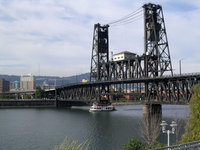Steel Bridge
|
|
The Steel Bridge is a through truss, double lift bridge across the Willamette River in Portland, Oregon. It carries railroad and pedestrian traffic on the lower deck, and Oregon Highway 99W, MAX light rail, and a vintage streetcar on the upper deck. It is the only double-deck bridge with independent lifts (the bottom deck can lift without the top deck moving) in the world and the second oldest vertical lift bridge in North America.
The first bridge was built in 1888 as a double deck swing span bridge (photo (http://shastaroute.railfan.net/Cards/SteelBr1.jpg)). It was the first railroad bridge across the Willamette River in Portland. The name originated because steel, instead of wrought iron, was used in its construction.
The extant structure was built by Union Pacific Railroad and the Oregon Railway and Navigation Company at a cost of $1.7 million. It opened in July of 1912 to rail traffic and on August 9, 1912 to automobiles. Between 1984 and 1986 the bridge underwent a $10 million rehabilitation including MAX construction. In 2001, a 220 ft (67 m) long and 8 ft (2.4 m) wide cantilevered walkway was installed on the south end of the bridge as part of the Eastbank Esplanade. The bridge is currently owned by Union Pacific with the upper deck leased to Oregon Department of Transportation, and subleased to TriMet.
The main span of the bridge is 211 ft (64 m) long. At low river levels the lower deck is 26 ft (7.9 m) above the water, and the upper is 72 ft (22 m) high. The decks operate independently of one another, allowing the lower deck to lift without disturbing traffic on the upper deck. The decks telescope into one another, providing 163 ft (49.7 m) of vertical clearance when both are raised. Each deck has it own counterweights, 2 for the upper and 8 for the lower, that have a total moving weight of 9,000,000 lb (4,100 metric tons). The machinery house is above the upper deck lift span with an operator's room suspended below the house so that the operator can view river traffic as well as the main deck. The average daily traffic in 2000 was 23,100 vehicles, 200 MAX trains, 40 freight and Amtrak trains, and 500 bicycles.
The lower deck of the bridge was threatened by major floods in 1948, 1964, and 1996.
At the east end of the bridge is the Rose Garden and Oregon Convention Center and at the west end is the Classical Chinese Gardens and Chinatown district.
External links
- http://www.odot.state.or.us/eshtm/textsteel.htm
- http://www.odot.state.or.us/eshtm/steel1.htm (Perspective view)
- http://www.odot.state.or.us/eshtm/steel2.htm (Elevation view)
Books
Wood, Sharon. The Portland Bridge Book. Portland: Oregon Historical Society, 2001. ISBN 0-87595-211-9.

